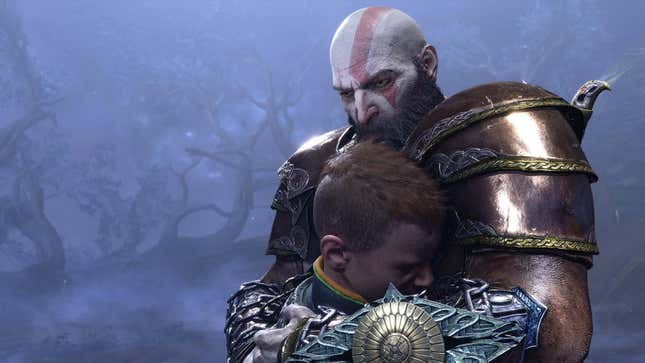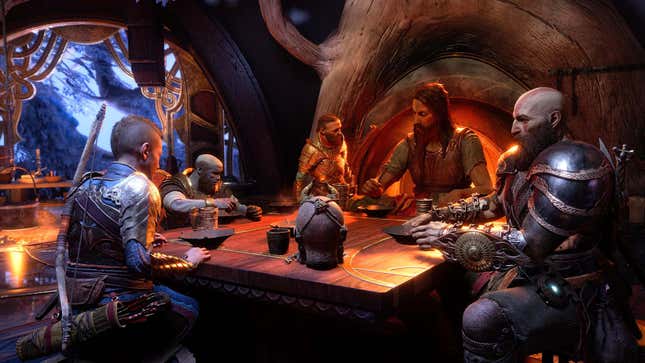Literally, nothing anyone can say will dissuade a certain set of PlayStation fans from playing God of War Ragnarök, the latest major Sony exclusive starring Kratos, the god killer himself. After years of waiting, the hype for this highly anticipated sequel has exploded beyond control. And while I have a few qualms, I’m here to report that, yes, Ragnarök is very good and will likely satisfy folks who loved 2018’s God of War and want to experience further adventure with Kratos and his boy.
God of War Ragnarök, out November 9 on PS4 and PS5, is the follow-up to 2018’s soft franchise reboot, which moved Kratos from the land of Greek gods to the world of Norse mythology. It also aged him up, gave him a young son to care for, and tasked the two of them with spreading the ashes of Faye, Kratos’ wife and Atreus’ mother. (Spoiler warning: If you didn’t finish 2018’s God of War and care about what happens, skip the next paragraph.)
That seemingly simple task led the two on a large-scale adventure involving gods and monsters, and helped the pair grow closer. Unfortunately, they also invoked the ire of Odin’s former wife, Freya, by slaying her son Baldur. And Baldur’s death triggered Fimbulwinter, a three-year season of ice said to precede the world-ending conflict known as Ragnarök. Meanwhile Atreus learned he’s half-giant—known as Loki to his mother’s people—and Kratos discovered a mural depicting his death. Fun times!
All of those story threads continue in God of War Ragnarök, which quickly establishes that Fimbulwinter is nearly over—meaning the world will end soon via Ragnarök—and that the now-older Atreus has been sneaking out to look for clues about his giant lineage and to possibly discover a way to prevent the cataclysm. Odin takes note, eventually forcing Kratos, Atreus, and friends to work together to foil the god’s scheming, save the world, and hopefully change fate to prevent Kratos’ demise.

Big epic stuff! But don’t worry, unlike other folks online lately, I won’t spoil any of what actually happens. That in mind, what surprises me most is that while the overall narrative is extremely large-scale and epic, the game spends most of its time focused on the relationship between Kratos, Atreus, and their friends.
Sure, Ragnarök is coming and Odin—one of the most powerful gods in all the nine realms—is trying to save his own skin, but that’s not really what this game is about. The greater focus is on Kratos and Atreus. The young boy isn’t a young boy anymore and he wants to live his own life and become his own man. Kratos isn’t dealing with that very well, falling back to his old ways to protect and control Atreus. This leads to tension, a lack of trust, and some tough moments. Their relationship is the heart of the game, and even when I’d sigh upon encountering yet another door puzzle, I’d push forward because I wanted to see what happened next.
Like its predecessor, Ragnarök is a third-person action-adventure; that means a lot of fights, and I mean a lot! Luckily, the killin’ is good, with combat feeling both heavy and responsive. Each swing of your axe or slice of your blades looks nice, sounds powerful, and feels satisfying. This time around you start out with both the awesome ice axe and the fiery Blades of Chaos.
This also means combat is a bit trickier from the start, with more complex engagements forcing you to switch up your weapons to counter different enemy types sooner. Eventually, you acquire a third weapon, a magical spear, that fits perfectly into the combat toolbox, but which I won’t spoil beyond that.
The big difference this time around is that you don’t only fight nasties as Kratos, but also as his son. While you could give Atreus commands in the previous game, this time around you get to actually play as him as he goes on his own adventures—sometimes without his dad knowing. These Atreus segments help shake things up and keep the combat from getting too stale, as the young son is much more range-focused with his bow and magic. These sequences also give Atreus more time to develop into someone beyond that kid Kratos called “Boy” all the time.
One particular extended Atreus segment around the game’s midpoint is one of my favorite parts from all of Ragnarök. Impressive stuff. While it might upset some fans, I’m happy Sony Santa Monica was confident enough to sideline Kratos at times to give his son more focus. The Arbiter levels in Halo 2 were a horrible mistake, but here the hero swap works and helps make Atreus a fully-formed character beyond just “the son of Kratos.” And more than just a minor detour, Atreus has his own weapons, skills, and abilities you can upgrade and tweak throughout the game.
Ironically, that also adds to one of my biggest problems with Ragnarök: too much menu fiddling.
I can’t stress enough how irritating I find all of Ragnarök’s various armor, weapon, and ability menus. Every few hours during my 35-hour playthrough the game added more stuff to manage and tinker with. You can upgrade every piece of armor and equipment. Some weapons and armor have to be crafted with a combination of two or three of the game’s dozens of crafting materials and currencies. You can also equip abilities and runes, and guess what, you can upgrade those, too. You also have to manage multiple skill trees, each of which contains skills that you can (yep!) tweak and upgrade.

Eventually, I acquired an amulet that had a dozen slots I could fill with various combinations of gems, and I sighed. I can’t imagine Kratos would actually want or care about all this stuff. I know I don’t. While I assume some players will get a kick out of min-maxing all the stats and skills; creating specific builds and whatnot, I just got tired of it all. I’m here to rip enemies in half and toss around a big ol’ axe, not to balance my taxes via seven different menus. Thankfully, if you just pick two stats and upgrade everything around those, you can mostly ignore all the fluff and still end up a powerful god-killer.
While at times God of War Ragnarök can feel more like a big DLC than a full sequel, it also tries to expand on the formula of the first game. One example of this can be found in some of the big, open-world-ish locations where you’re free to explore and complete side-quests and objectives in whatever order you choose. These segments remind me a lot of the similar moments in Uncharted 4 and Gears 5. Like those games, Ragnarök doesn’t go full open world, but instead uses these larger areas to experiment a bit.
These freeform segments will likely be controversial. I liked how they slowed things down and let the characters talk more as I explored for collectibles and upgrade materials, but I imagine some players will find these areas too big and empty, devoid of action or fun. The one thing I believe everyone will agree on is that these sequences, like the rest of the game, are filled with puzzles. Perhaps…too many?
Some of Ragnarök’s puzzles can be amusing to figure out, striking that perfect balance between being hard enough that you feel smart solving them and easy enough that they don’t become roadblocks to progress. But far too many of the puzzles end up feeling like busywork, just a way to slow you down over and over. And frustratingly, one mechanic involving triggering magic arrows with elements is far too finicky, often not working when it should. It’s a bummer that the second half of Ragnarök has so many of these puzzles, which sort of ruins a lot of the later side dungeons and puzzle rooms.
Beyond the annoying puzzles and fantastic combat encounters, I was really struck by how often Ragnarök just lets things breathe. The game is filled with quiet moments, some of which can go on for as long as you want.
One standout involves Atreus, Kratos, Mimir, the blacksmiths, and a few others all gathered around a small table and eating a meal together in awkward silence. The game just lets you sit there for as long as you want as characters fidget about and try to make small talk. Another involved Atreus skipping stones on a river. Again, you can skip this moment or stick around and listen to characters talk, tell stories, or share their feelings with you.

That’s not to say God of War Ragnarök is a quiet game. It’s a visually impressive and exciting adventure that, at least on PS5, runs at 120fps and is filled with gore, action, and intense moments of destruction. But it also never forgets the real focus should always be on its characters. Kratos and Atreus are the heart of this new era of God of War. Ragnarök provides them plenty of quiet moments and lets you see just how much they’ve grown and developed since 2018. Getting to see the journey they take together to reach this new point in their lives is truly my favorite part of this sequel.
Yes, the axe is cool. Sure, the fights are tons of fun. And I definitely enjoyed exploring every nook and cranny of the large worlds you get to visit. But what kept me glued to my PS5 for nearly 40 hours was the story of a son becoming a man and a father trying to figure out how he feels about that. I probably could have enjoyed this story a tad more with about half as many puzzles and skill menus, but even so, I found myself smiling, feeling satisfied, as the credits rolled. As I said at the start, God of War Ragnarök is very good.
